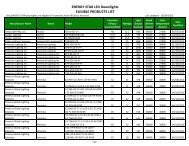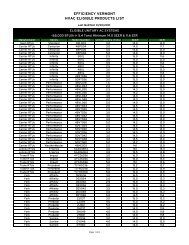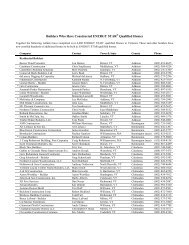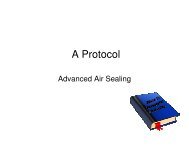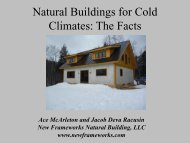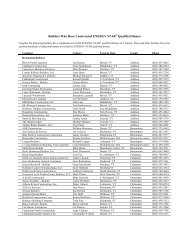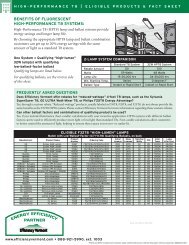Infrared Camera & Envelope Systems pdf - Efficiency Vermont
Infrared Camera & Envelope Systems pdf - Efficiency Vermont
Infrared Camera & Envelope Systems pdf - Efficiency Vermont
You also want an ePaper? Increase the reach of your titles
YUMPU automatically turns print PDFs into web optimized ePapers that Google loves.
esolution, the thermograms helped the owners negotiate<br />
a financial settlement with the architects and contractors.<br />
A great value of infrared thermography is that it provides<br />
a means of seeing the invisible thermal signatures related<br />
to many of these problems in building. When properly<br />
used, thermography enables building owners, architects,<br />
contractors and inspectors to locate problems, verify<br />
building performance, and validate solutions. When<br />
people act on this information, significant savings result<br />
and buildings are more comfortable!<br />
All surfaces radiate invisible heat energy. You’ve felt this<br />
energy emitted by the sun or a stove burner. <strong>Infrared</strong><br />
cameras are specially-designed electronic devices that<br />
detect thermal radiation. They convert this radiation into<br />
thermal images, or thermograms, which visually portray<br />
temperature differences as small as 0.05°C.<br />
These portable, battery-operated instruments record<br />
the thermal data either as still, digital images or on<br />
conventional videotape or digital video. The image is<br />
displayed live in a viewfinder or on an LCD view screen.<br />
Different radiant temperatures are shown as different<br />
colors or shades of gray. Although it may sometimes be<br />
useful to display temperature values, this is often not<br />
required in building work. Rather the differences are what<br />
is usually of interest.<br />
Given the right conditions most buildings exhibit<br />
characteristic thermal patterns that can be interpreted by a<br />
qualified person. The infrared systems themselves are quite<br />
easy to operate and, thus, a number of thermographers<br />
conduct building inspections. The tasks of interpreting<br />
the imagery, understanding the root cause problems, and<br />
finding solutions are all more difficult. Because of this,<br />
thermographers often work closely with a team consisting<br />
of building specialists, architects, and contractors.<br />
The key to using thermography successfully is<br />
understanding what thermal patterns are associated with<br />
the problems being studied and knowing when those<br />
patterns will become visible in the infrared image.<br />
Image 2. When conditions are right, it is possible to locate<br />
missing or damaged insulation, such as this poorly installed<br />
injected foam in a residential building.<br />
Building applications for thermography<br />
Thermography has been used since the mid-60s to<br />
solve building problems. During the late 70s and<br />
early 80s, a time when fuel prices rose dramatically,<br />
thermography was embraced widely as a tool to<br />
help determine building performance. Since then<br />
other applications have been developed and refined, especially<br />
related to verification of structural performance.<br />
The major building-related applications for the technology<br />
are detailed below.<br />
l Insulation checks<br />
Missing, damaged or non-performing insulation will<br />
stand out clearly in a thermal image when there is at<br />
least a 10°C (18°F) stable temperature difference between<br />
the conditioned space and the outside air. If is often<br />
possible to do work with less of a temperature spread<br />
due to differences in the thermal capacitance of the<br />
building materials. The inspection is typically done from<br />
both inside and outside. Often the best results are gained<br />
from inside because of fewer influences, but a better<br />
overall understanding of the building can often be gained<br />
from larger views of the outside elevations.<br />
It is essential to know the type of insulation in the<br />
building and construction details, including how the<br />
insulation was installed. Insulation may be in place but<br />
not performing; often a destructive evaluation is<br />
warranted to establish baseline conditions or understand<br />
the exact construction detail. Each type of insulation<br />
has a characteristic thermal pattern. Image 2 shows a<br />
classic pattern associated with injected foam insulation<br />
in a wood-framed wall. This type of insulation, a soft<br />
foam, is susceptible to shrinkage and cracking when<br />
poorly installed.<br />
© 2008 The Snell Group / www.thesnellgroup.com



